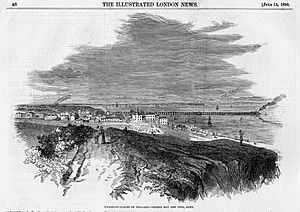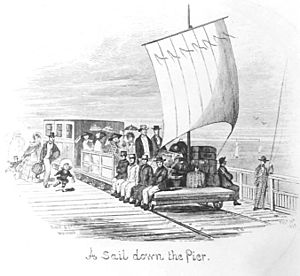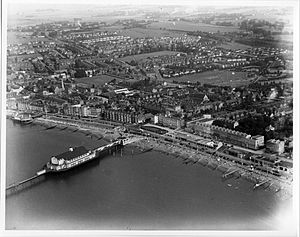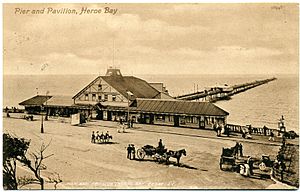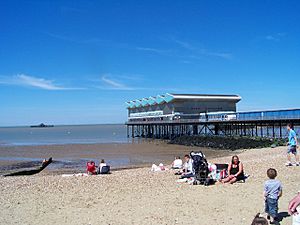Herne Bay Pier facts for kids
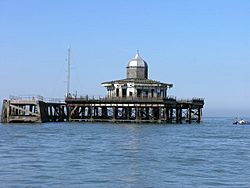
Herne Bay Pier landing stage in 2006
|
|
| Official name | Herne Bay Pier |
|---|---|
| Type | Passenger steamer landing stage; tourist attraction |
| Carries | Steamer passengers; tram; pedestrians |
| Locale | East Kent |
| Design | Head Wrightson & Co of Thornaby-on-Tees |
| Owner | 1899−1909 Herne Bay Pavilion Pier and Promenade Co 1909−1974 Herne Bay UDC 1974− Canterbury City Council |
| Total length | 3,787 feet (1,154 m) |
| Opening date | Easter 1899 |
| Destruction date | 11 January 1978 |
| Toll | 2d (1899) → 1s 6d (1968) |
The Herne Bay Pier was a very long pier built in Herne Bay, Kent, England. It was the third pier constructed in this town. Piers are like long walkways built out over the water. They allow boats, especially large steamers, to dock easily. People also use them for walking, fishing, and enjoying the sea views.
This pier was incredibly long, stretching for about 3,787 feet (1,154 m) into the sea. It was even featured in a movie called French Dressing. Sadly, a big storm damaged it in 1978, and it was taken apart in 1980. Today, only a short part of it remains near the shore, and a separate section of the old landing stage is still out at sea. Before this famous pier, Herne Bay had two other piers.
Contents
History of the Piers
The First Pier
In the early 1800s, Herne Bay was a tiny place. But then, more people started visiting, often arriving by boat from London. These boats, called hoys, couldn't get close to the shore. Visitors had to transfer to smaller boats, which could be a bumpy ride! So, people decided they needed a proper pier.
A group of investors, led by George Burge, hired Thomas Rhodes to design the first pier. Rhodes had worked with the famous engineer Thomas Telford. This first pier was built from wood. It was 3,613 feet (1,101 m) long and 24 feet (7.3 m) wide. Construction started on July 4, 1831, and it opened on May 12, 1832. The first passengers arrived on a steamer called Venus.
The pier was made entirely of timber. It was considered very well-built for its time. At the entrance, there was a curved stone fence. These stones came from the old London Bridge, which was taken down in 1831. A special vehicle, nicknamed Neptune's Car, ran along the pier on tracks. It was powered by sails and sometimes pushed by pier workers. This trolley carried passengers and their luggage.
The pier's length was important because it needed to reach water deep enough for the steamers. Even far out, the sea was quite shallow. In 1861, a railway station opened in Herne Bay. This helped the town grow into a popular holiday spot. However, the wooden piles of the pier started to rot because of tiny sea worms. By 1860, the pier was in bad shape. The pier company also struggled because most visitors started arriving by train instead of by steamer. The first pier was taken down between 1870 and 1871.
The Second Pier
In 1871, the local authorities bought the land leading to the pier. They also bought the old pier for £475 to finish taking it down. A new, shorter pier was built quickly. It opened on August 27, 1873. The Lord Mayor of London, Sir Sydney Waterlow, officially opened it with a big celebration. There were parades, fireworks, and dances.
This second pier was designed by Wilkinson & Smith. It was built with strong cast iron piles filled with concrete. It had a bandstand at the end where music was played. But it was only 328 feet (100 m) long. This was too short for steamers to dock. So, it was mainly used for walking and entertainment. The stone fence from London Bridge was kept at the entrance. Even though a wooden theatre and shops were added, the pier didn't make much money.
The Third Pier
A Busy Time
People really wanted a pier long enough for steamers again. So, in 1895, the pier company got permission to build a deep-sea pier. The short pier was rebuilt, and then the long extension began. The third pier was made of iron. It was designed by Head, Wrighton & Company. It cost £60,000 to build. It even survived a huge storm in 1897 that damaged the town's promenade.
The pier was finished in 1899. At 3,787 feet (1,154 m), it was the second longest pier in England! Steamers used the pier until 1963. The PS Medway Queen was one of the last steamers to visit. At the end of the pier, there was a restaurant. It was a round, wooden building with a dome. It still stands today and is used as a cafe.
An electric tram ran along the pier. It carried people from one end to the other for just a penny. In 1909, the local council bought the pier. They thought the old theatre at the entrance was too small. So, in 1910, they built a new, much larger building called the Grand Pier Pavilion. It cost £2,000 and could seat a thousand people. It had a special floor for roller skating, dancing, and other events. The Lord Mayor of London, Sir John Knill, opened it on August 3, 1910.
The Grand Pavilion survived a fire in 1928 that destroyed other buildings at the pier entrance. In 1924, the pier got a new electric tramcar. The pier entrance area was rebuilt in 1932 after the fire.
During World War II
During World War II, the army took over the pier. They covered it in barbed wire and camouflage netting. The tram was used to carry army supplies. In June 1940, the army blew up two sections of the pier. This was to stop enemy forces from landing there. They later used temporary Bailey bridges to cross these gaps. Some people think these gaps and bridges weakened the pier. This might have led to its destruction later.
After the war, the council received some money for war damage. But it wasn't enough to fully repair the pier. They focused on fixing the Grand Pavilion and the main structure. Steamers started calling at the pier again by 1947.
After the War
In 1950, the pier tram was sold. It couldn't cross the Bailey bridges. A small steam railway replaced it, but that was gone by 1959. The pier entrance was damaged by storms in 1949 and again in 1953. During the North Sea flood of 1953, a huge storm surge swept far inland. As a result, the old stone fence from London Bridge was removed in 1953. Its current location is unknown.
In 1963, the sea around the pier froze solid for weeks. This caused stress to the pier's piles. That summer, the PS Medway Queen made its last visit. By 1968, the far end of the pier was closed and abandoned. The Grand Pier Pavilion was refurbished, but then it burned down in June 1970. This was a sad event for Herne Bay. A new building, called the Pier Pavilion, was opened in 1976. People nicknamed it The Cowshed. In 1974, the pier's ownership was transferred to Canterbury City Council.
Destruction and What's Left
People who enjoyed fishing and others wanted the pier fixed. But more storms in 1978 and 1979 caused the middle part of the pier to collapse. The remaining sections were taken down in 1980. The very end of the pier, the pier head, was too strong to demolish. So, it remains isolated out at sea. It has a solar-powered light to help boats navigate.
Since then, groups have been interested in rebuilding the deep-sea pier. There have been plans and studies, but nothing has happened yet. In 2008, Roger Gale, a Member of Parliament, suggested that a casino might have helped fund the pier's reconstruction. The Canterbury City Council also set up a charity to raise money for rebuilding the pier.
In 2010, a report suggested selling other local sites to pay for a new building on the remaining pier stub. The sports pavilion on the stub was demolished in 2012. Drone footage in 2015 showed the pier head was crumbling. In 2019, there were worries that the pier head was at risk of collapsing.
Social History

In 1899, two old signal cannon were found near the pier. These cannons were used to warn ships in fog. They were later placed on the steps of the Herne Bay Clock Tower. The Duke of Cambridge visited the pier in 1837 on a steamer. There were a couple of accidents on the first pier involving the trolley. In 1901, the electric tram on the third pier went through the railings, causing a fatality.
The pier stayed open during World War I. However, steamers were used for war service, and entertainers went off to fight. The tramcars became shelters. A dancer named Lydia Cecilia Hill performed at the old Pier Theatre until it burned down in 1928. In 1941, a Wellington bomber plane crashed into the sea near the pier.
A famous airspeed record was set between Herne Bay Pier and Reculver in November 1945. H.J. Wilson broke the World Air Speed Record at 606 miles per hour in a Gloster Meteor jet. Cricketer Godfrey Evans used to box on the pier for fun.
From 1910 to the late 1960s, the Grand Pavilion hosted summer shows, winter pantomimes, and exhibitions. The later Pier Pavilion, nicknamed The Cowshed, had public roller skating sessions. It was also home to two successful roller hockey clubs. Other sports like badminton, judo, squash, and five-a-side football were played there.
For many years, young people have enjoyed jumping off the pier into the water. There is also an annual crab-catching competition held on the pier stub. The pier is often used as a marker for boat races.
Images for kids


